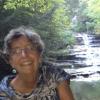
Faith leaders unite in a prayer circle to open the People's Climate March September 21. Faith groups joined the 300,000 people participants in seeking global solutions to climate change. (Emma Cassidy/People's Climate March)
Religious folk are not so good at a lot of things, but we are experts at ritual. The Mass. The wedding. The baptism. The bar mitzvah. The funeral. The praise service.
At Sunday’s People’s Climate March, we multi-faith types joined the rest of the 300,000-plus people who love the earth enough to march it to create a ritual. When a ritual works, people feel something. They are changed. They come in the door one person and go out another.
The best moment was at 12:58 p.m., Eastern time, when a call went out for two minutes of silence. It was real. Quiet in New York City? Very much so.
And then a secular ritual -- the wave -- joined the quiet, starting from the back and waving all the way through the thousands gathered.
Like an ululation -- an Arabic shout that accompanies ritual -- the sound built its joy and pierced the quiet with happiness. Everyone I spoke with said that that was the moment worth the bus rides, the sleeping on floors and the expensive packaged food.
For me, it was an urban bliss, a sacralization of all that has been desacralized, a punctuation marking off the time before we had hope we could love the earth from the time when we forgot or did not. Hope waved its arms and its voice at us, and we waved back. I know “the wave” mostly happens at large sports events, but so what? The blend of the sacred and the secular, the earth and the heavens was everywhere Sunday.
At Lincoln Center, there was a floating of the lanterns at 7 p.m., when the light was most splendid. On Monday, a sea of blue shirts and dresses appeared at Flood Wall Street, where people were getting arrested as I wrote.
Ritual is most real when it has truth to it. Like the way the Mass tells us that eating together is sacred or that Jesus wanted us to remember it that way. The truth at Flood Wall Street was powerful: we know that profit impedes the way of healing for the earth. It is time to wave that truth all around town and country.
But before the wave Sunday, there was an extraordinary outdoor prayer service that featured celebration and lamentation and renewal of commitments. Music sang from the cello, from gospel singers, from Peter Yarrow and Neshama Carlebach. Rabbi Arthur Waskow chanted a lament for the earth, written by Rabbi Tamara Cohen.
During the march, 30 of us rode on the ark, created by Auburn Theological Seminary, and remembered how generous God is, even to those who forgot the rainbow again. And, yes, we did pass out animal crackers.
A concluding service was held at the Cathedral of St. John the Divine, where fancier people spoke while our tired feet rested. We used stones as symbols of our commitment. And Episcopal Rev. James Kowalski, dean of the cathedral, promised to make it more green ongoing, as are many congregations in New York City and beyond.
Imagine the truth of our places yielding green truth in their real estate as well? I wonder, would our attendances increase as our rituals got more real? At least we would join those who marched with solar panels, alongside our arks and our stones and our chanting.
Throughout the weekend, we housed several hundred people at Judson Memorial Church, in Greenwich Village. They slept on the floor and in the hallways. About a hundred of them were from the Poor People’s Campaign in Philadelphia.
I admit it: I was worried the place would be a mess and we’d be cleaning up after our guests for weeks. Not only was the place spotless Monday morning but also our microwaves have all been scoured.
When I returned to the church Sunday night to check on things, I found an old woman working away on the grunge in the microwave. I was more than humbled, and told her she didn’t need to do that. She agreed, replying “I didn’t have to. I wanted to.”
We march planners and participants worried how climate change would coalesce with other issues: racism or Ferguson, immigration and deportation, sexual violence and women’s rights, or homophobia. What happened is that the march was much more than white (our worst fear) and so close to a rainbow that you could almost hear Noah’s exclamation at the return of the dove.
People were surprised to see what the The New York Times called, “some odd juxtapositions” of faiths -- the Quakers and the pagans, the Catholics and the Jews, the Muslims and the Buddhists, joined by at least one Unicorn.
In my actualized hope, after Sunday’s multiple “services,” I imagine something different than The Times -- I imagine a usual juxtaposition of faiths.


